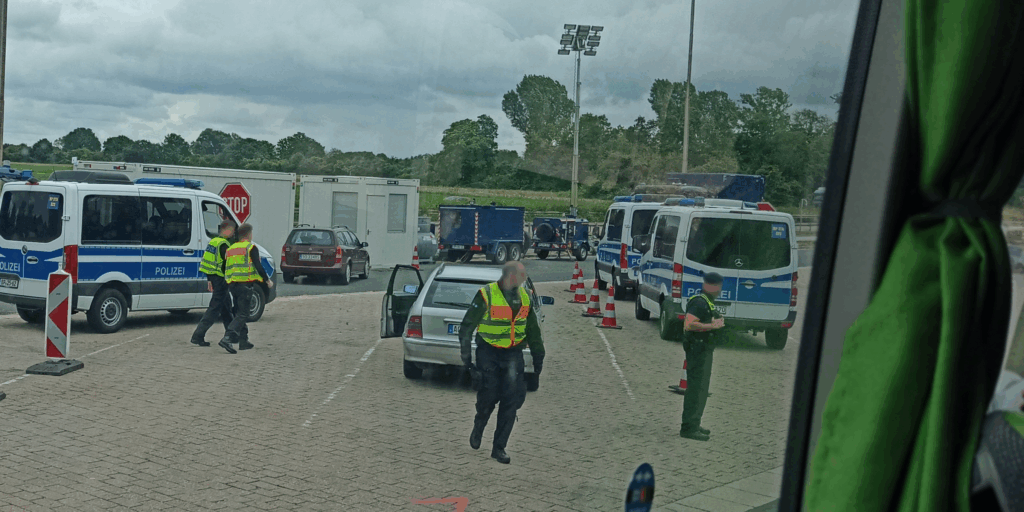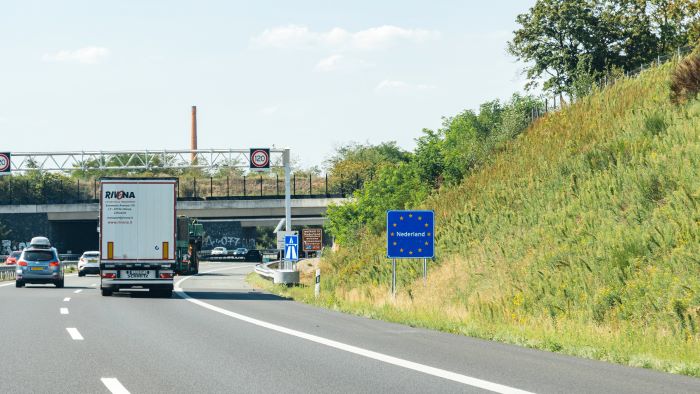
Pim Mertens
Scientific coordinator

Martin Unfried
Senior researcher
“In an area where persons may move freely, the reintroduction of border control at internal borders should remain an exception. Border control should not be carried out or formalities imposed solely because such a border is crossed”, recalls recital 21 of the Schengen Borders Code. Yet rarely has the list of notified border controls been so long. Since 2006, there have been 473 notifications of internal border controls to the European Commission, a vast majority of them only since COVID-19 (2020). The list had only just passed the 100 mark at the end of 2019. Currently, we are halfway through 2025 and already in that half-year, 14 notifications have been made. Schengen member states are currently controlling their land borders, with almost all checks being carried out with multiple neighbours. In cooperation with partners, ITEM is investigating the border controls. In the following, we describe how the Schengen exception has become a normal state today. It is notable here that the notifications of Schengen member states cite the limitation of migration as the main reason, although there are other agreements between member states regarding migration.
Normalisation of border controls
Scholars also speak of an era of so-called re-bordering, in which the national management of national borders has become normalised. This normalisation started since the migration crisis in 2015 with COVID-19 as a catalyst 5 years later. Since then, the trend of land borders as a national tool has been perpetuated. In official notifications, migration-related issues in relation to public safety are by far the most frequently cited argument in this regard.[1] To curb intra-EU mobility of asylum seekers, many member states now resort to border controls.
Repeatedly, combating terrorism or the threat of terrorism has also been mentioned as a reason for border controls.
Whereas recital 26 of the Schengen Agreement initially stated that ‘migration and the crossing of external borders by large numbers of third-country nationals should not be considered per se as a threat to public order or internal security’, this was amended with the revision of the Schengen Agreement in the summer of 2024. Indeed, Article 25(1)(c) now prescribes as a possible cause of a serious threat to public policy: “an exceptional situation characterised by sudden large-scale unauthorised movements of third-country nationals between the Member States, putting a substantial strain on the overall resources and capacities of well-prepared competent authorities and which is likely to put at risk the overall functioning of the area without internal border control, as evidenced by information analysis and all available data, including from relevant Union agencies.”
A study commissioned by the European Parliament was quick to criticise this, precisely because the Schengen Borders Code did not authorise internal border controls as a migration tool.[2] Other European agreements and rules, such as the Dublin Regulation, were established for that purpose. Forty years ago , the five member states Belgium, the Netherlands, Luxembourg, France and Germany signed the Schengen Treaty, abolishing internal border controls. Except for Luxembourg, now even the founding members of the Schengen treaty implement some form of controls. All four motivated by, among other things, asylum flows. Although border controls should by definition be temporary and an ultimum remedium, Germany and France have been carrying out border controls for years – with or without a different legal basis. The following table provides an overview of the controls notified today.
| # | Country | Duration | Reasons/Scope |
| 1. | Poland | 07/07/2025 – 05/08/2025 | Persistent migratory pressure along the borders with the Republic of Lithuania and the Federal Republic of Germany; land borders with Germany and Lithuania. |
| 06/08/2025 – 04/10/2025 | Continued persistent migratory pressure along the borders with the Republic of Lithuania and the Federal Republic of Germany; land borders with Germany and Lithuania | ||
| 2. | Slovenia | 22/06/2025 – 21/12/2025 | Serious threats to public policy and internal security posed by a high level of terrorist threats and organised crime, including human smuggling and arms trafficking, the risk of terrorist infiltrations into migratory flows via the Western Balkans, hybrid threats from the Russian Federation and Belarus, as well as instability in the EU’s neighbourhood, including Russia’s ongoing aggression against Ukraine and instability following the fall of Assad’s regime in Syria; land borders with Croatia and Hungary. |
| 3. | Italy | 19/06/2025 – 18/10/2025 | Continued threat of terrorist infiltrations into migratory flows along the Western Balkan route, ongoing crises in the Middle East and Ukraine, high level of irregular migration including a strong presence of criminal smuggling and trafficking networks, and heightened security risks associated with the Universal Jubilee of the Catholic Church; land borders with Slovenia. |
| 4. | Austria | 12/05/2025 – 11/11/2025 | Threats associated with the continued high levels of irregular migration and migrant smuggling across Austria’s southern borders, as well as the strain on the asylum reception system and basic services, Russia’s ongoing war of aggression against Ukraine and the security situation in the Middle East, intensifying the threat posed by Islamist extremism and terrorism; land borders with Hungary and Slovenia. |
| 16/04/2025 – 15/10/2025 | Threats associated with irregular migration, such as via the Balkan routes (including expected migratory pressure), as well as the strain on the asylum reception system and basic services, Russia’s ongoing war of aggression against Ukraine, and the security situation in the Middle East aggravated by terrorist groups; land borders with Slovakia and Czechia. | ||
| 5. | The Netherlands | 09/06/2025 – 08/12/2025 | Serious threat to public policy caused by high levels of asylum applications, irregular migration, migrant smuggling, and secondary movements, leading to an overburdening of the migration system in general and the asylum system in particular, as well as pressure on public services, including housing, health care and education; land and air borders with Belgium and Germany. |
| 6. | Denmark | 12/05/2025 – 11/11/2025 | Serious threats to public policy and internal security posed by possible sabotage actions from Russia, as well as continuous terrorism-related events and organised crime, notably, tied to the Israeli-Hamas conflict and driven by radicalisation from groups such as Islamic State and Al-Qaida. These threats include potential attacks on Jewish and Israeli targets; land and sea borders with Germany but may extend to all internal borders. |
| 7. | Norway | 12/05/2025 – 11/11/2025 | General threat aimed at the energy sector, threats of sabotage posed by the Russian intelligence service, as well as to increase infrastructure protection; ports with ferry connections to the Schengen area. |
| 8. | Sweden | 12/05/2025 – 11/11/2025 | Serious threats to public policy and internal security arise from organised cross-border crime and terrorism, highlighted by attacks involving military-grade explosives against foreign institutions and the public, including the involvement of foreign state actors leveraging criminal gangs, coupled with persistent threats from violent Islamist groups and individuals; all internal borders (land, air, and sea) and land borders with Denmark. |
| 9. | France | 01/05/2025 -31/10/2025 | Serious threats to public policy, public order, and internal security posed by persistent jihadist threats, a rise in antisemitic attacks, the growing criminal networks facilitating irregular migration and smuggling, and irregular migration flows towards the Franco-British border that risk infiltration by radicalised individuals, as well as the irregular crossings on the Channel and North Sea borders, along with rising violence among migrants, particularly in northern coastal areas such as Dunkirk and Calais, leading to tense and perilous situations for both migrants and law enforcement; all internal borders (land, air, and sea) with Belgium, Germany, Luxembourg, the Swiss Confederation, Spain, and Italy. |
| 10. | Germany | 16/03/2025 – 15/09/2025 | Serious threats to public security and order posed by continued high levels of irregular migration and migrant smuggling, and the strain on the asylum reception system. The impact of the global security situation (including Russia’s war of aggression against Ukraine and the situation in the Middle East) on security and migration; land borders with France, Luxembourg, Belgium, the Netherlands, Denmark, Austria, Switzerland, Czechia, and Poland. |
A semantic discussion?
Under the Schengen Borders Code, border checks are defined as “the activity carried out at a border, in accordance with and for the purposes of this Regulation, in response exclusively to an intention to cross or the act of crossing that border, regardless of any other consideration, consisting of border checks and border surveillance”. On the other hand, under Article 23 of the Schengen Borders Code, it is also possible to carry out checks within the territory without formal border controls. For this, however, it must not be equivalent to border checks, therefore, among other things, not systematic but information- and risk-based and not having the objective of border control or border surveillance. Nevertheless, a look at the Benelux countries and Germany quickly shows that formal border control or not, there are differences but also similarities.
| Country | Schengen treaty | Method | Mobile / fixed | Capacity controls |
| Belgium | Entry controls under article 23 SBC | Identity checks at transport hubs (such as Brussels-South), at major approach roads, on international bus traffic and intra-Schengen flights from countries with high migrant arrivals (such as Greece and Italy). | Mobile | Equal |
| Luxembourg | n/a | n/a | n/a | n/a |
| Netherlands | Border control under Articles 25 and 25a SBC | Controls are not systematic, but information- and risk-driven. Controls may take place at border crossings, international trains and specific flights. Checks take place within existing capacity, with no widespread static border checks. | Mobile | Equal |
| Germany | Border control under Articles 25 and 25a SBC | From September 2024, controls will apply on international trains, buses, trams and motorways. From May 2025, border controls have been intensified. This involves the installation of fixed checkpoints at border crossings, with speed and traffic regulation measures. All vehicles can be checked, including trains, buses and trams. Fixed checkpoints are not set up at all border crossings. In addition, Germany carries out mobile border checks in the border area within 30 kilometres of the border. | Fixed + mobile | Intensified |
| France | Border control under Articles 25 and 25a SBC | Border controls with all neighbouring countries have been in place since 1 November 2024. Risk-based mobile checks are carried out within the area of 30km of the border, on roads and railway stations. | Mobile | Intensified |
Germany as an exception: fixed border posts
Germany already has a longer history of border controls and notifications under the Schengen Agreement. However, from 16 September 2024, these border controls were extended to all (nine) neighbouring countries. With the new coalition in Berlin, border controls have been intensified from May 2025. This includes the establishment of fixed border posts along selected German border crossings, which can be relocated after a certain period of time. Currently, border posts on the border with the Netherlands and Belgium are reported at border crossings around Aachen (from the Netherlands and Belgium), at Steinebrück (Belgium-Germany border), Elten/Kleve (from Arnhem), Bunde (from Groningen) and Bad Bentheim (from Hengelo), among others.[3] The German ADAC further reports several regular and/or prolonged border controls along the German border with Austria (such as at Suben, Walserberg and Kiefersfelden), Poland (Frankfurt, Forst, Ludwigsdorf), Switzerland (Basel, Weil am Rhein and Kruzlingen-Konstanz) and the Czech Republic (Breitenau-Schönwald, Schirnding).[4] Delays and traffic jams are very frequent at these German fixed border posts.
In addition, mobile border controls are carried out within the border area of 30 kilometres to the border. Trains, buses and trams can also be checked – which, based on anecdotal evidence, also happen with regularity.
France: mobile on information, with intensified capacity
France is also among the countries with a long history of border controls, because of various grounds and circumstances argued. Since 1 November 2024, border controls have been in place with all neighbouring countries for reasons including migration. Border controls are mobile in a 30km zone from the border, without fixed border posts, and are carried out on the basis of information and risk analysis. In particular, checks are carried out at important, busy border crossings and there is visibility from the French authorities.
Belgium and the Netherlands: mobile, based on information and risk assessments
A first method of controls is targeted based on information and risk assessments. In this, checks are mostly mobile, in the border area or more inland.
Belgium’s checks are an example of this. Starting this summer, a cooperation of the federal and local police and the Immigration Department conducts so-called entry checks. The argument for entry controls is based entirely on migration and asylum flows. “Our message is clear: Belgium will no longer tolerate illegal migration and asylum shopping”, said Minister Van Bossuyt.[5] The entry controls have not been notified to the European Commission as formal border controls, but invoke “checks within the territory” of Article 23 of the Schengen Convention. Controls are mobile at major approach roads and transport hubs and ‘targeted’ based on risk assessments.
Controls as carried out by the Netherlands also follow this approach. In fact, the Dutch and Belgian methods are very similar. Although the Netherlands did formally notify border controls to the Commission, the Dutch Royal Marechaussee also does not carry out systematic but targeted checks based on information and risk analysis. Since 2022, the Netherlands already had intensified MTV (Mobile Surveillance Security) checks – a security measure under national law (under the possibilities of Article 23 of the Schengen Borders Code). MTV checks can only be used for illegal migration and cross-border crime. Deviating from the practice under MTV checks, the Marechaussee is now allowed to carry out checks without restriction (24 hours per day) and at all border crossings. Under MTV checks, this was limited in scope (limited questions allowed), time (maximum 6-12 hours of checks per day), frequency (such as how many trains and flights can be checked) and space (up to 20 kilometres from the border).[6] However, similar to the practice under MTV checks, the capacity of the State Police has remained. As capacity has not been significantly increased, controls remain ‘mobile’ and information-driven.
| MTV | MTV intensive | Border control | |
| Basis | Article 23 SBC | Article 23 SBC | Article 25 SBC |
| Method | Mobile and information-driven | Mobile and information-driven | Mobile and information-driven |
| Control | Limited sampling | Limited sampling | Unlimited, all passengers possible |
| Scope | Limited search allowed | Limited search allowed | Extended search possible |
| Time | Maximum 6 hours of road checks per day | Maximum 180 hours per month and 12 hours per day | Unlimited |
| Frequency | No more than three trains per route and 20 trains in total; seven flights per week per flight route and no more than one-third of total scheduled flights per month | No more than six trains per route and 40 trains in total; no more than half the number of flights per day. | Unlimited |
| Space | On roads and waterways limited in an area up to 20 kilometres from the border | On roads and waterways limited in an area up to 20 kilometres from the border | Up to the border possible, and along the entire border or in several places at the same time |
Border control: what’s in a name?
With that, the question then arises as to what is effectively the difference between a formal border control as introduced by the Netherlands and the entry control as legally instituted by Belgium. A semantic discussion?[7] It should not be taken so lightly. After all, checks under Article 23 of the Schengen Convention should not be similar to a border check. The definition of a border check leaves a lot of room, thus mostly to the assessment of whether it should be a check under Article 23 or a border check under Article 25. Article 23 of the Schengen Borders Code sets a number of guidelines:
- Checks should not have border control as their purpose, i.e. control activities that exclude because of the intended or actual border crossing is done and consists in control or surveillance of the border;
- Based on general police information, intended to combat cross-border crime, reduce illegal migration or contain an infectious disease;
- They shall be planned and executed in a manner clearly distinct from systematic checks on persons, including when carried out at transport hubs or on board passenger transport services and provided they are risk-based.
Checks under Article 23 should therefore, unlike border checks under Article 25, be risk- and information-based, take place digitally as much as possible, and it is not the border crossing as such that should be the focus but can be used as a means. The distinction between and (im)possibilities in MTV controls and border controls as highlighted in Table 3 shows the difference in definitions and legal space.
While the legal space is therefore wider for the Netherlands than for Belgium, the effective effect may be similar. After all, both countries have not increased enforcement capacities and do not deploy systematic, but information-driven and random checks. This shows that it is not only the legal space that is decisive, but rather the political space. Statements by politicians from the (former) ruling PVV party made it clear that they see German border controls as an example and want to follow Germany’s example.[8] This has also been confirmed in the PVV document ‘The limit has been reached’ (De grens is bereikt) with regard to Germany’s intensified controls. [9] However, the notification under Article 25 has not yet led to intensive or fixed controls along German lines, to the relief of border municipalities and their residents.
In conclusion: (un)lawful and (un)necessary?
Border controls are the last resort and only allowed if no other alternatives are possible to achieve the objective. In doing so, border controls must be legitimate, justified and proportionate. Although the argument for border controls is increasingly based on migration and asylum, the legitimacy here is mostly questionable. As indicated earlier, until recently, the Schengen Convention did not state that asylum and migration as such cannot be arguments for introducing border controls. After all, free movement within Schengen applies to everyone – regardless of nationality. Even now, strict requirements are tied to this argument with significant figures and an obligation to have asylum reception in order[10] (which is often insufficiently the case).
The legitimacy of the border controls carried out has been frequently criticised in the past and this criticism is also increasing today. For where Member States normalise the use of border controls, this is subject to careful obligations and considerations under the Schengen Treaty. In practice, border controls are not the last resort, let alone the right tool for the oft-cited asylum and migration argument. Just recently, the Court of Audit in the Netherlands ruled that border controls are not, nor can be, an effective instrument to control asylum inflows. In legal terms, too, this reality of border controls to keep out asylum seekers was recently reiterated by the Verwaltungsgericht in Berlin: the practice of Germany turning away asylum seekers at the border is not allowed.[11] To this end, European agreements have been made under the Dublin III Regulation, which Germany must comply with. According to the Dublin Regulation, the Federal Republic is obliged to fully carry out the procedure provided for in the Regulation in any case when asylum applications are lodged on German territory. This so-called Dublin procedure is concerned with determining the Member State responsible for the asylum procedure. Three Somalis were unlawfully turned back by the Bundespolizei because they had lodged an asylum application, so that, according to the court, they were allowed to cross the border and await the Dublin procedure in Germany.
Although curbing asylum (inflows) and migration is often and increasingly used as an argument for internal border controls (almost in all current notifications), the suitability and legitimacy of internal border controls as a tool against asylum inflows and migration should be firmly questioned. Internal border controls are only possible for temporary and serious threats to public order and security, and not so much for controlling incoming mobility. For asylum and migration as such, other European frameworks and agreements are needed, such as the European Pact on Migration and Asylum.
As part of the ITEM Cross-Border Impact Assessment 2025, ITEM, together with TEIN partners, examines the effects of border controls in several European border regions. The full publication, with a more in-depth analysis will follow this autumn.

[1] Wille, C. (2025) On the Reintroduction of Temporary Controls at EU Internal Borders. UniGR-CBS Working Paper Vol. 24.
[2] Carrera, S., Colombi, D., Cortinovis, R. (2023). An Assessment of the State of the EU Schengen Area and its External Borders. Brussel: European Parliament’s Committee on Civil Liberties, Justice and Home Affairs.
[3] See here also: https://www.anwb.nl/vakantie/nieuws/2024/september/controle-bij-landsgrenzen-in-duitsland Also based on own experience.
[4] https://www.adac.de/news/deutschland-grenzkontrollen/
[5] https://www.vrt.be/vrtnws/nl/2025/06/19/grenscontroles-illegale-migratie/
[6] Article 4.17a et seq. Vreemdelingenbesluit 2000; Article 50 et seq. Vreemdelingenwet 2000.
[7] As articulated by Belgian Minister Van Bossuyt, https://www.vrt.be/vrtnws/nl/2025/06/19/grenscontroles-illegale-migratie/
[8] For example, Geert Wilders has explicitly stated that he wants to follow the German example. https://www.nporadio1.nl/fragmenten/dit-is-de-dag/9cfc3e15-1b9a-4d9d-8282-646f80497a92/2024-09-11-wilders-wil-net-als-duitsland-paspoortcontroles-weer-invoeren-wat-betekent-dit-voor-schengen
[9] https://www.pvv.nl/nieuws/geert-wilders/11398-persconferentie-pvv-geert-wilders-asiel.html
[10] Article 25(1)(c) jo. Article 27(3) SBC.
[11] Verwaltungsgerichts Berlin, Beschlüsse der 6. Kammer vom 2. Juni 2025 (VG 6 L 191/25 u.a.), https://www.berlin.de/gerichte/verwaltungsgericht/presse/pressemitteilungen/2025/pressemitteilung.1565917.php.

